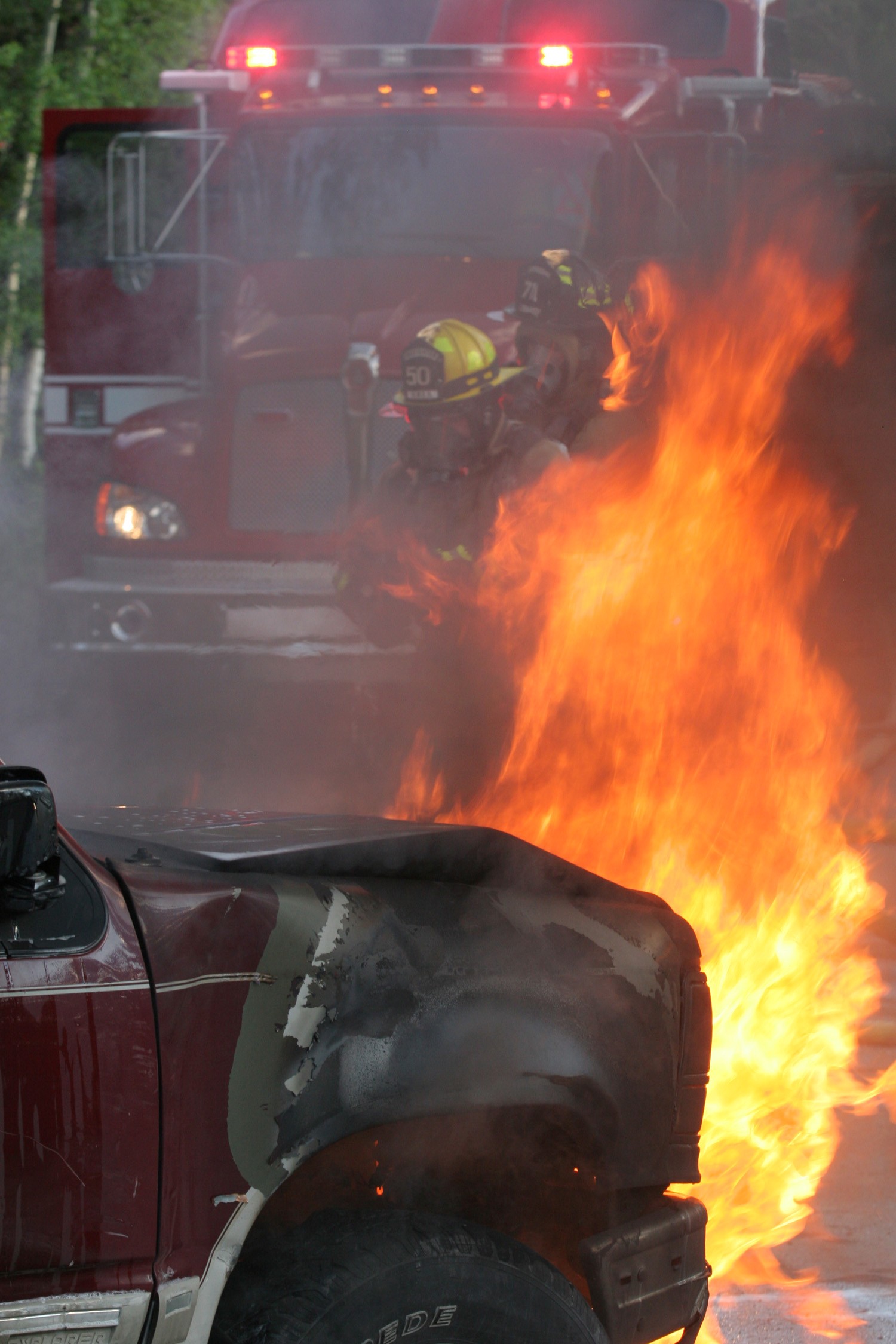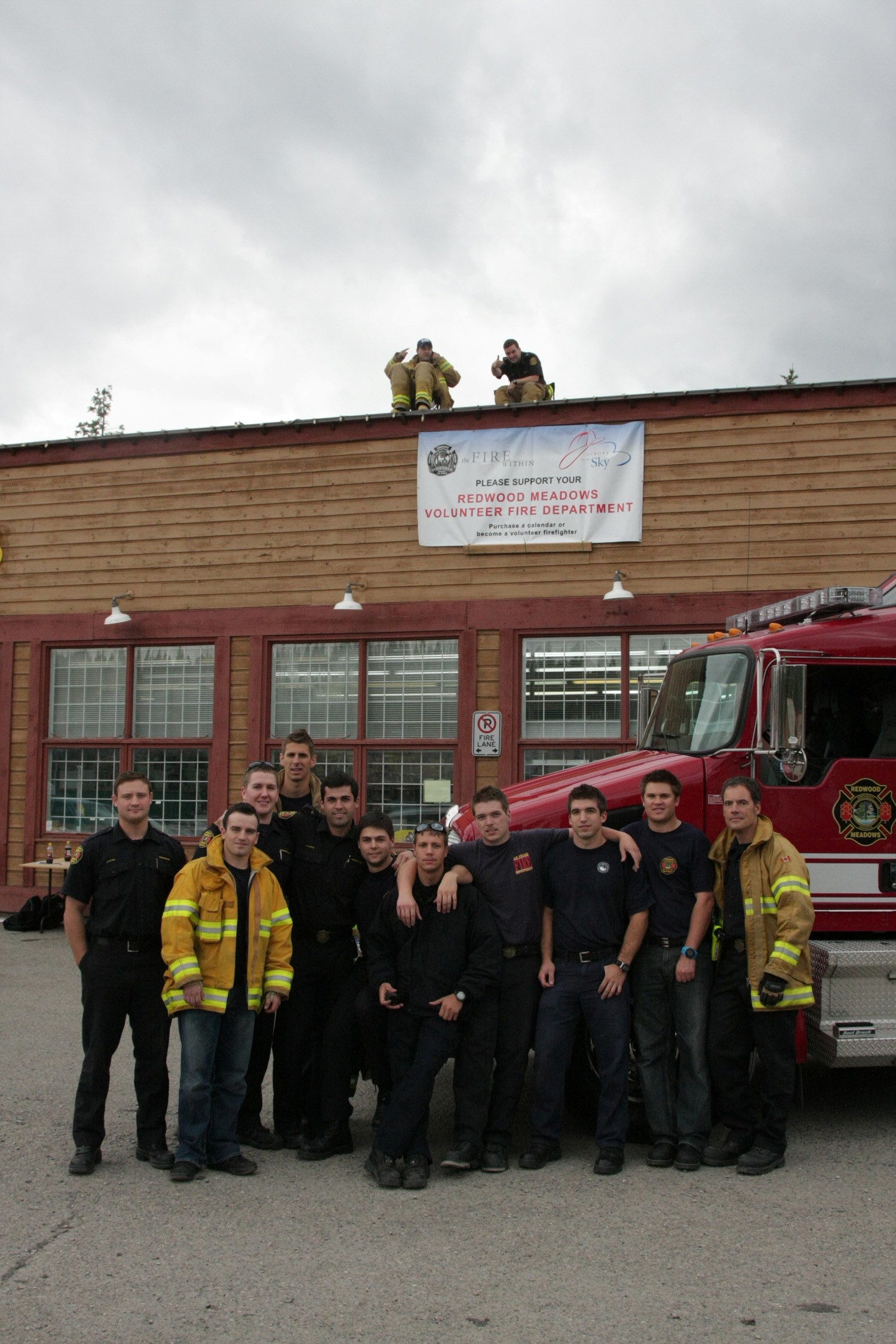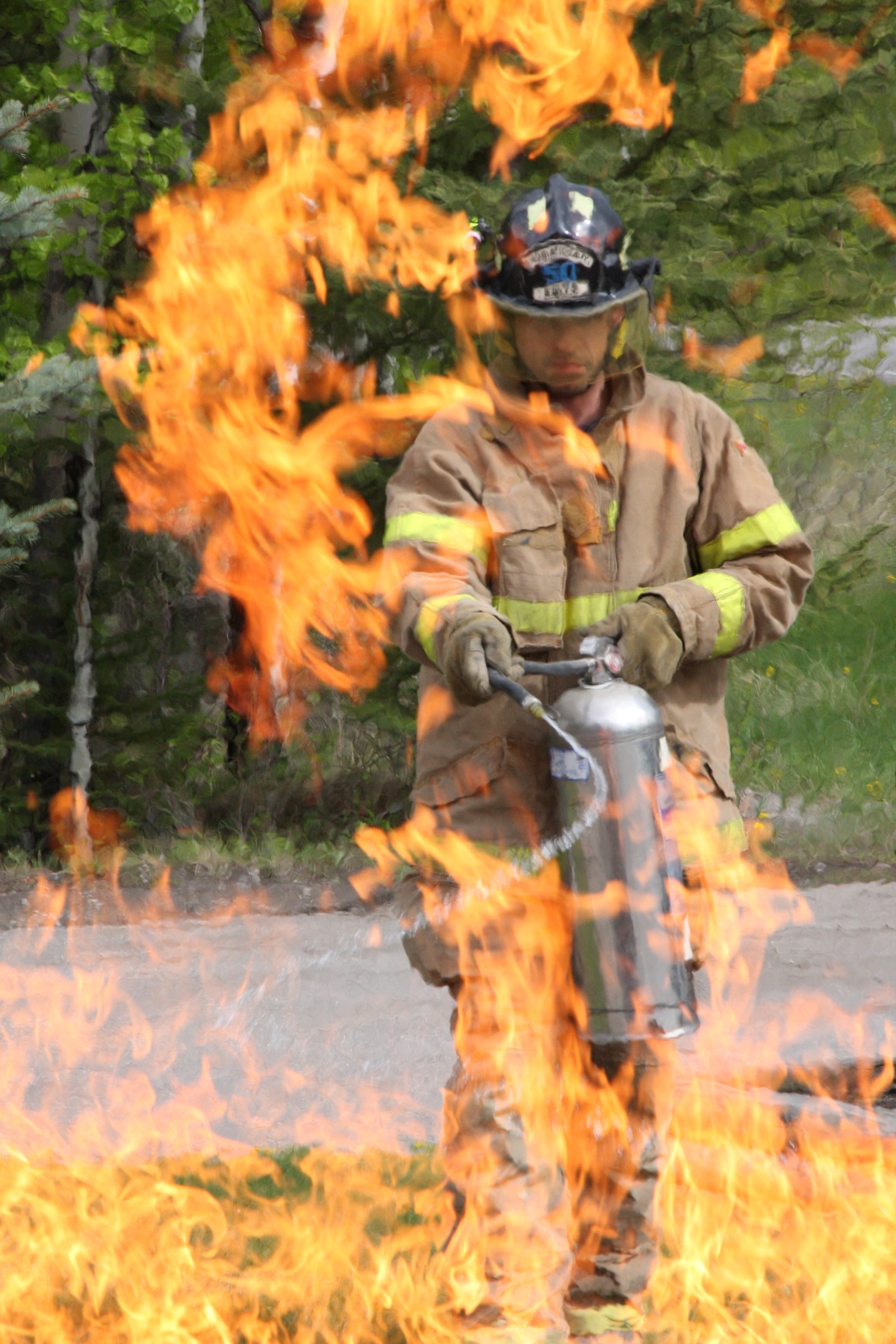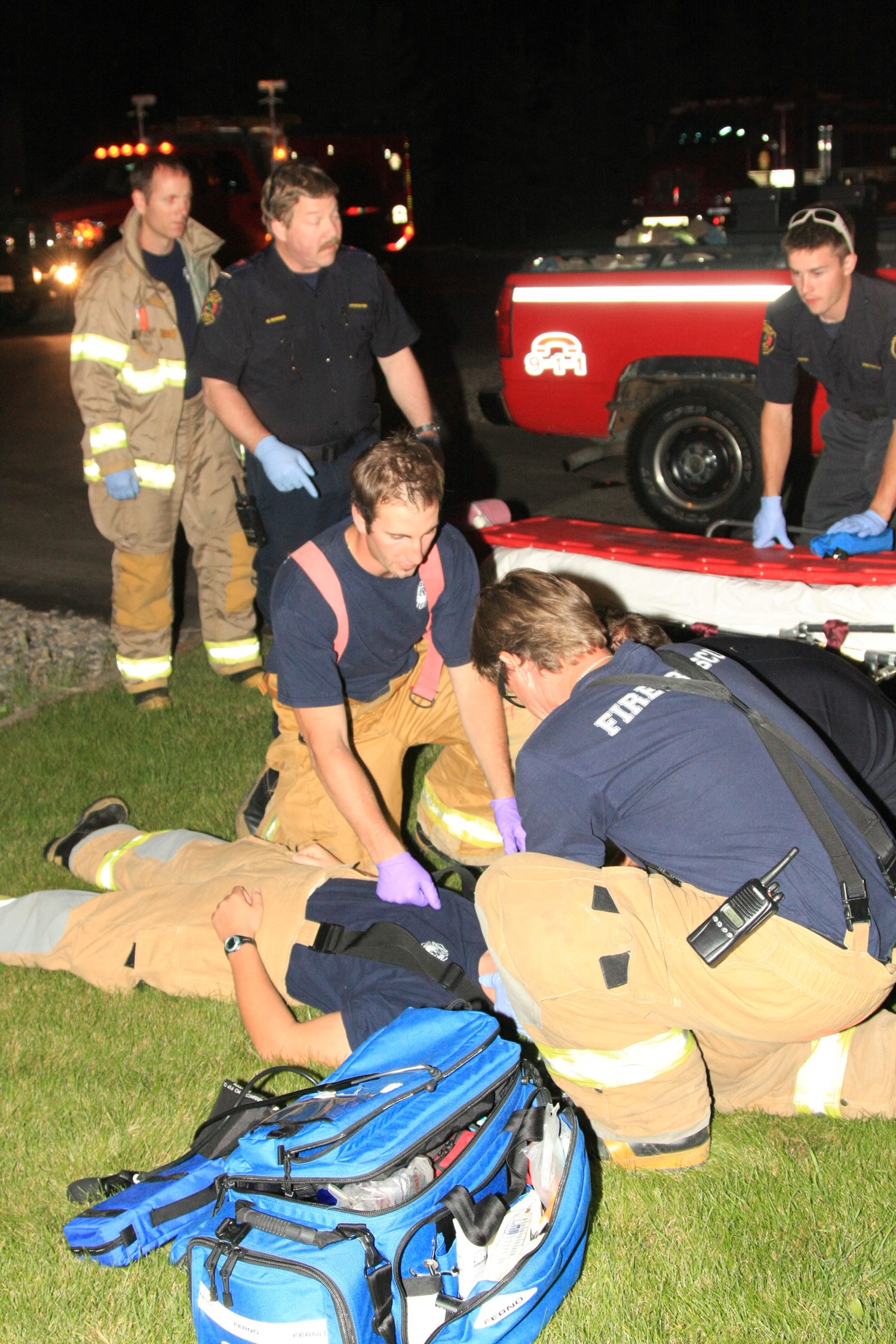
Features
Volunteers
Committed contingent
Feb. 11, 2011 - While fire departments in some parts of Alberta have closed their doors during the day or shut down altogether because there aren’t enough volunteers to meet the demand for service, the all-volunteer Redwood Meadows Emergency Services has created a recruitment and retention model that works.
February 11, 2011
By Rob Evans

|
|
| A Redwood Meadows Emergency Services (RMES) firefighter prepares to attack a car fire during vehicle firefighting training. RMES is fully staffed with volunteers but wants more local recruits. Photo by Rob Evans |
“There has been a significant change in the demographic of our community over the last 10 years,” says Lt./EMT Gary Robertson. “Most people commute to Calgary for work and are working standard office hours. As the demographic of our community changed, so did our membership. We have had more of an influx of younger men and women into the department, many of whom have the ambition to make this a career.”
There are 3,492 fire departments in Canada, of which 91 per cent are staffed by volunteer men and women. More than 78 per cent of Canada’s 108,000 firefighters are volunteers, and it is becoming more difficult to find them and even harder to keep them.
The Canadian Association of Fire Chiefs says volunteer firefighters, on average, give their communities 443 hours of work each year. In the small town of Redwood Meadows, the 37 members of Redwood Meadows Emergency Services (RMES) put in more than 17,000 hours of volunteer work in 2010, an average of 459 hours of community service for each member.
A team of RMES officers and firefighters works hard to gather and maintain staffing in the small community 25 kilometres west of Calgary. The department’s Probationary Development Team consists of one captain, two lieutenants and a firefighter. The team follows recruits through information sessions, the application process, interviews, a modified Candidate Physical Ability Test, and their probationary year with the department.
The department requires all members to wear uniforms while on duty, at community functions, while on courses and at weekly in-service training. This helps to promote pride and ownership within RMES. However, presenting a very professionally run volunteer department intimidates a number of local residents.
“The biggest challenge faced by RMES is recruiting local volunteers,” Robertson says. “By the time people finish work and balance their family and recreational schedules, they don't have much time left to want to commit to something like volunteer fire fighting.”
The department manager says they will focus on recruiting locally during 2011. last year, the recruitment campaign slogan was Looking for a rewarding way to give back to your community? Come volunteer with us! While the campaign succeeded in getting new recruits, just one out of 10 was from Redwood Meadows.

|
|
| Many of Redwood Meadows 2010 recruits helped at the launch of the 2011 Fire Within calendar. The Heroes in the Sky fundraising event helps to promote the department and make residents more aware of the need for volunteers. Photo by Rob Evans |
The new recruitment program features firefighters currently employed by RMES. According to Robertson, the newest literature will feature an image of two people, standing side by side, one member in regular job clothes, the in some aspect (fire, medical, rescue) of the department.
“It will be actual members who live and work within our community, recognizable faces to most people,” Robertson said. “We really want residents to see that the people on the fire department are the same people they see at the store or out walking the dog, and that they, too, have what it takes to be a firefighter.”
The recruiting team has tried to capture this in the slogan Your firefighters VOLUNTEER, your firefighters are people just like YOU. This slogan will be featured on the RMES website and on all RMES posters and on information flyers Redwood Meadows residents will receive in the mail.
“We want to reach as many people as possible and posters have proven to be too passive,” Robertson says. “Not everyone looks at them or retains the information. This way we get their attention right in their homes. We are also looking into a banner to hang outside the station that will remind people of the flyer they got in the mail.”
RMES is willing to try many things to attract and retain volunteers, but reducing the amount of training for new recruits and current members to entice more volunteers is not an option, says Chief Training Officer George Low.
“A fully trained department is more effective in all aspects of its activities,” he says. “As a volunteer department, we never know who will be able to respond to any given incident. Our level of training ensures that the crews will be equipped to handle most emergencies.
“At the same time, our training makes us a much safer department. Losses are minimized and costs of accidents are also reduced. The pride evidenced within the department results in an eagerness to participate.”
Giving recruits the opportunity to respond to calls quickly is important to the department, as this keeps recruits interested in their new roles. Lt. Mike Norman says this is critical to retain the newest members.
“First, this is not a paid department, so the recruits and seasoned members are doing this service out of interest and commitment and it’s important to provide that rewarding feeling as soon as possible,” Norman said.

|
|
| A RMES probationary firefighter uses a fire prop at the fire station. The department’s Probationary Development Team follows recruits through their entire probationary year with the department. Photo by Rob Evans |
“Secondly, it’s important early on for recruits to understand the underlying command structure at a scene that looks – to the untrained eye – as chaotic. Also, the sooner recruits can adjust to the heightened excitement that can accompany an emergency situation, the more they can put their theoretical training to use.”
Once new recruits are part of the normal operations of the department, efforts to retain their services have to pick up as the firefighters advance in their experience and training.
“We use the professionalism and advanced training opportunities to provide an attractive balance for younger career-oriented members from outside the community being asked to donate large amounts of time to RMES,” Norman says. But he notes that members living in the community contribute differently than those who do not live in the area.
“While members living in the response area can be at home doing other things while waiting for a call, members from outside the community who are waiting at the station for calls are dedicating time solely towards RMES.”
RMES is looking at other incentives to keep membership numbers steady and to retain members who live inside and outside of the community. Simple gestures, such as offering rookie and firefighter of the year awards, have kept morale high for the past few years.
“Throughout the year, (the department) provides promotions through the classes of firefighter,” Robertson says. “It all helps to contribute to a sense of appreciation and sets goals for the members to work toward. It also shows there is potential for growth within the ranks of the service, which helps eliminate that dead-end sensation some jobs experience.”
Supplying uniforms, t-shirts and ball caps to firefighters so they look professional while on duty makes the crews look good and contributes to the sense of pride.
Appreciation from the community also speak volumes. “Saying, ‘Thanks for coming out,’ or ‘Thanks for fixing that’, giving out a water bottle or buying the crew pizza all go a long way,” Robertson says. “We ask so much of them that these small gestures are the least we can do, but they often resonate the most because they are true, genuine appreciation.”

|
|
| RMES is a 100 per cent volunteer department. It’s volunteers participated in a medical training scenarios last summer. Many of RMES events involve the families of its volunteers so they will better understand the role of the department and its volunteers. Photo by Rob Evans |
Appreciation of the members’ families is also important to the members of the busy volunteer department. “They are invested as much as the volunteers,” Robertson says. “They are woken up in the middle of the night by the pager, have holidays interrupted by calls, vacations scheduled around courses and without their support it wouldn't work.”
Several times a year, the firefighters host brunches and barbeques, to which they bring their families. At Christmas, there’s a family party and town councillors come out and thank the department. Robertson says he believes that having families involved in department activities is a key to keeping people around.
“It's a crucial part of retention, because if their family is unhappy with them being on the fire department it will cause stress at home and they will end up leaving the department.”
Making sure members are comfortable with the duties they’re asked to perform when they’re on a call is also important, Robertson says. “We also strive to operate an environment where members are not tasked with doing activities they aren’t comfortable with. If, for example, a member isn’t comfortable with medical care, they can still be useful doing traffic control, or firefighting activities.”
Through exit interviews, the recruitment team has learned that it’s important to ensure that volunteers feel confident about what is expected of them, especially volunteers who have other jobs that prevent them from devoting as much time to external training as those looking for a firefighting career.
Recruitment and retention can be challenging but with innovation and thought, it is possible to entice and hang on to the people who contribute so much to their communities.
Rob Evans is the deputy fire chief for Redwood Meadows Emergency Services, 25 kilometres west of Calgary. Evans attended the Southern Alberta Institute of Technology in 1989 and studied photojournalism. In 1992 he joined RMES after taking pictures of an interface fire and making prints for the department. He has his NFPA 1001 level II certification, NFPA 472 Operations and Awareness (hazmat), NFPA 1041 level I (fire service instructor), Henson College Fire Service Leadership certificate and is a registered Emergency Medical Responder with the Alberta College of Paramedics. He lives in Redwood Meadows with his wife, a firefighter/EMT with RMES, and three children.
Print this page